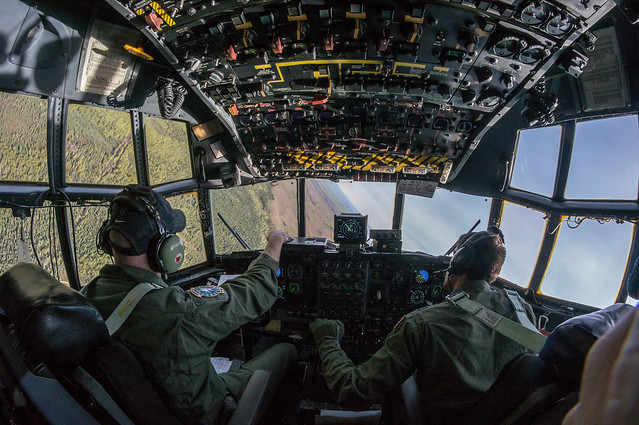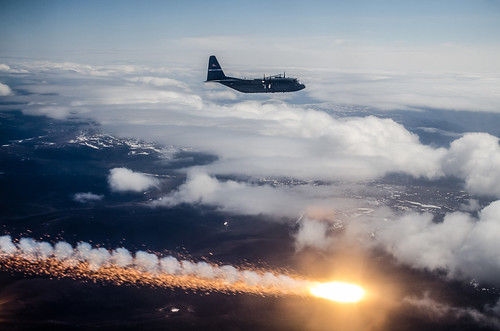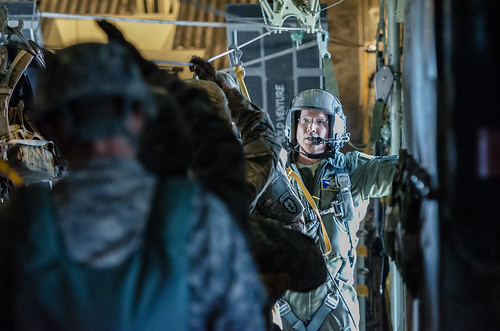Story by Master Sgt. Phil Speck, 123rd Airlift Wing Public Affairs
[caption id="" align="aligncenter" width="550"]

An aircrew from the Kentucky Air National Guard’s 165th Airlift Squadron flies a Kentucky Air National Guard C-130 Hercules over the mountains of Alaska during a training scenario as part of Red Flag-Alaska on May 15, 2014. More than 100 Kentucky Airmen participated in the exercise from May 7 to 23. (U.S. Air National Guard photo by Senior Airman Robert Buchberger)
JOINT BASE ELMENDORF-RICHARDSON, Alaska – More than 100 Airmen from the Kentucky Air National Guard completed 10 days of intense combat training here May 23, airlifting 35,000 pounds of essential cargo and airdropping 280 Army paratroopers into enemy territory while facing attacks from hostile aircraft and surface-to-air missiles.
The training, part of a regular Pacific Command exercise called Red Flag - Alaska, exposed Kentucky's C-130 aircrews to a "hyper-realistic training environment" that will strengthen their preparation for combat missions in any setting, said Col. Robert Hamm, commander of Kentucky's Louisville-based 123rd Operations Group.
Click here for more photos from this story.
[caption id="" align="alignleft" width="341"]

A Kentucky Air National Guard C-130 Hercules flies in formation as another C-130 deploys flare countermeasures in the skies over Alaska during exercise Red Flag-Alaska on May 22, 2014. Aircrews from Kentucky’s 165th Airlift squadron received intensive combat training during the exercise, which ran from May 7 to 23. (U.S. Air National Guard photo by Master Sgt. Phil Speck)
“The fast pace and high tension of the exercise required our Airmen to maintain constant focus despite being mentally and physically fatigued throughout,” Hamm said. “It was as close as it gets to the stress they’ll have to endure in actual combat.
“Our guys accomplished every one of their learning objectives, and I think it opened up a lot of their eyes about how serious this is — about how different (combat) is from the way we train locally because we can’t create the same conditions back home.”
Among those differences were the ability to train alongside escort and strike aircraft while facing threats from aggressors in the air and on the ground. Kentucky’s three C-130s were escorted into and out of hostile territory by F-15 and F-22 fighters, whose mission was to eliminate enemy aircraft and surface-to-air missile batteries, Hamm said.
The Kentucky Airmen also had the opportunity to navigate challenging mountain terrain in the Pacific-Alaska Range Complex where the exercise was staged, and to interoperate with a full spectrum of assets from AWACS to A-10s, working with each of these units to plan and execute every mission.
Lt. Col. Matthew Quenichet, director of operations for the 165th Airlift Squadron, was pleased with Kentucky’s performance in such an intense environment.
“It was a big accomplishment just to survive the sortie, hit your time-on-target, make your landing, pick up your cargo, and get it to the end of the vulnerability zone,” he said.
[caption id="" align="alignright" width="358"]

Chief Master Sgt. Jeffrey Brown, a loadmaster from the Kentucky Air National Guard’s 165th Airlift Squadron, prepares the paratroop door on a Kentucky Air Guard C-130 Hercules for Soldiers from the 2-377th Parachute Field Artillery Regiment, 4th IBCT 25 Infantry Division, while flying just north of Joint Base Elmendorf-Richardson, Alaska, on May 13, 2014. The jump was part of Red Flag-Alaska, a Pacific Command exercise designed to provide aircrews with realistic combat training. (U.S. Air National Guard photo by Master Sgt. Phil Speck)
That vulnerability zone is where the simulated war took place. Aircraft from Joint Base Elmendorf-Richardson and Eielson Air Force Base, Alaska, would meet there to begin the conflict. Units took turns being allied forces or aggressors, while C-130 crews executed various scenarios in which they had to fly through treacherous terrain, land on dirt-strip runways, pick up cargo, and airdrop cargo or Army paratroopers.
This exercise marked the first time that Army forces were integrated into the training, and the Kentucky Air Guard became the first Air Force unit ever to drop paratroopers into an airfield for a simulated seizure during Red Flag – Alaska.
“There was a lot of apprehension going into this,” Quenichet said. “People were not sure what to expect, but they were excited. It was a lot for people to take in. The idea was to throw more challenges at the aircrews than they would ever see in actual combat.”
Two groups of Kentucky Airmen participated in the exercise, Quenichet added: Highly experienced aircrews with extensive combat exposure in Afghanistan; and brand-new co-pilots, engineers and loadmasters who had never seen anything like it before.
“It may have taken the new aircrews an entire career to get this kind of experience, but they got it in their first couple of months in the airplane here,” Quenichet said. “We worked together as a team to get a game plan and accomplish this mission. Once we were en route, it wasn’t a simulator. It was real airplanes flying through incredibly challenging terrain, facing actual threat systems. The only difference between the scenarios here and real combat was that there weren’t pieces of metal flying at you.
“By the end of the exercise, all our aircrews were right where they needed to be.”
[caption id="" align="alignleft" width="350"]

A Kentucky Air National Guard C-130 flies over Alaska on May 9, 2014, in support of Exercise Red Flag-Alaska. More than 100 Kentucky Airmen from the 123rd Airlift Wing participated in the exercise from May 7 to May 23. Red Flag-Alaska is designed to hone the combat skills of U.S. Air Force flight crews. (U.S. Air National Guard photo by Master Sgt. Phil Speck)
Lt. Col. Kevin Allred, commander of Detachment 1, 353rd Combat Training Squadron, said the event was one of the smoothest Red Flags he’s seen.
“I’m very impressed all the way around,” Allred said. “From the deployment to getting in to town, they were all over everything. All of your crews were fired up to be here — that’s really fun to watch. I think everyone got really good training out of it, because they wanted to be here.”
Allred also said he was pleased by how smoothly the Army integration went, adding that officials plan to build on the airfield-seizure scenario in future exercises.
Hamm credited the 353rd with providing excellent support throughout Red Flag — a factor that helped the Kentucky Airmen maximize their training opportunities.
“The 353rd Combat Training Squadron provided outstanding support for a phenomenal exercise,” Hamm said. “There was no tension, and we got everything we asked for. We couldn’t ask for better support from those guys.”